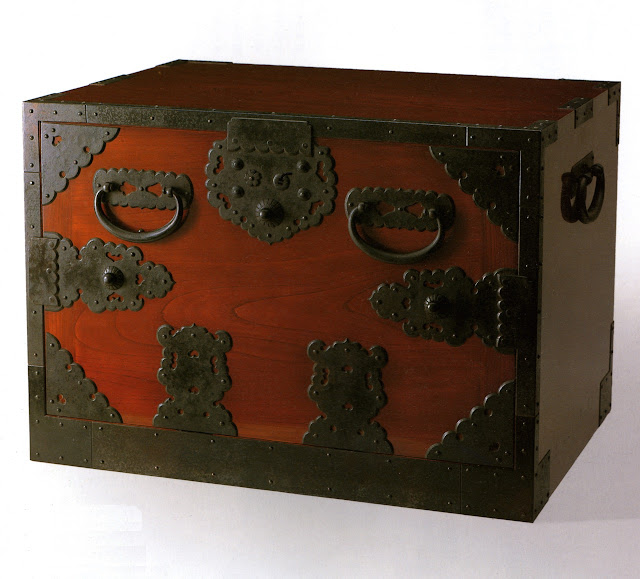Dedication Personified
All serious craftspeople are dedicated. That goes without saying. But amongst so many Ryohei Kido’s degree of commitment and dedication is something special.
 |
This chest flirts with tradition in a meaningful way, without being a simple reproduction.
Photo courtesy of Ryohei Kiko.
|
On leaving University he began working for a regional newspaper as a journalist. It was then that he become interested in tansu—the chests which have now become so popular outside of Japan. But it was the sea chests in particular that interested Ryohei.
He bravely decided to pursue a new career after meeting a maker of fine interior fittings. Soon after becoming an apprentice, however, his sensei, Yoshio Yotsuya suddenly passed away. What was Ryohei to do? He had a family to support but was determined to learn woodworking skills.
On opening the front door of this kakesuzuri sea chest, a number of drawers are revealed but there is much to frustrate the would-be thief. Locks are not the only irritation. Photo courtesy of Ryohei Kido.
While engaged in some formal training at two different firms making timber household fittings, he continued to visit stores to increase his knowledge of tansu in general and funa-dansu—sea chests—in particular.
Returning to the same stores, he gradually became more and more familiar with the chests of his passion and, at the same time, got to know the store owners, who began to understand just how sincere and passionate Ryohei really was. Eventually store owners began to ask him to do some repairs and thus “the sea chests became my teacher”.
What is seen hides what is cunningly concealed. This is a relatively simple example of how boxes can be hidden in such a way as to thwart and foil a would be thief, not only in finding them but in extracting them, too. Image courtesy of Ryohei Kido.
At first he began by making the more simple kakesuzuri sea chest—a combined safe and stationary chest. It was not unusual for such chests to have hidden compartments and drawers, so making such devices was something that Ryohei had to study.
He later began to make larger chests, either with hidden compartments of a type he had seen before, or to actually develop his own ways of concealing spaces and boxes within the body of a chest. For one of his customers he even had to make a video to demonstrate how to access and use the concealed compartments he had devised.
 |
This larger sea chest could be carried ashore for the Captain, who would do business with local merchants at the port of call. Photo courtesy of Ryohei Kido.
|
It was not just the woodwork skills he had to acquire. Ryohei also made a point of making all the metal fittings too. Like the wood, these are coated with true lacquer, heat being used to effect the bond between the two materials. Nails and locks also had to be made. With no previous experience of working in metal, it was his wife, Akiko, who took on some of this work.
 |
The locks and keys are individually made by Ryohei, with the assistance of his wife.
Photo courtesy of Ryohei Kido.
|
Although more recently Ryohei has concentrated on the making of sea-chest-style pieces, he is far from a slave to tradition. He is inventive and adapts what he makes to suit modern conditions, while still stylistically flirting with historical styles and methods.
 |
This simple sword chest would not look out of place in the modernest of interiors with its simple lines and beautifully finished fittings and figured zelkova wood. Photo courtesy of Ryohei Kido.
|
In complete contrast to the precision and glowing artistry of the his sea chests, Ryohei has also explored another form of cabinet making. This is a knock-down chest made of boards which still bear the scares of a traditional Japanese broad bladed saw. Photo courtesy of Ryohei Kido.
His Nomad chest displays other interests. It has a character that could not be further from that of the sea chests—not showy but still highly appealing. It was inspired by a piece of Afghan furniture. He used a traditional Japanese panel saw to cut the boards and expressed the scares left by the saw using several applications of true lacquer.
Resolute and determined, Ryohei continues to make exciting pieces of furniture—traditions are respected and moulded to satisfy his passions and contemporary life styles. Whatever he does he remains dedication personified.
If you would like to see more of Ryohei’s work, please copy and paste iwate.info.co.jp/funadansu/ or enter 木戸良平 (his name in characters) for images of his work. Alternatively go to his FaceBook page https://www.facebook.com/seachest.hakoya/.
All images courtesy of Ryohei Kido
Do feel free to pass on the address of this blog to anyone you think will be interested. Or share it on social media. Should you wish to leave a comment, please do so by clicking on the comment mark at the bottom left of this or any of the other posts. If you have found this blog interesting, why not become a follower. Thank you.





No comments:
Post a Comment